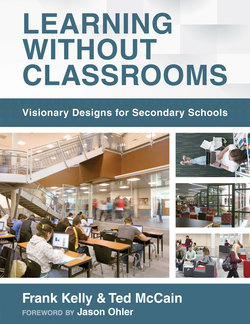Читать книгу Learning Without Classrooms - Frank Kelly - Страница 8
На сайте Литреса книга снята с продажи.
ОглавлениеFOREWORD
by Jason Ohler
We will always want schools in some form. They may remind us of the patch of ground beneath the shade of the olive tree where Socrates and his students sat to debate truth and logic. They may consist of constellations of simple, satellite-connected rooms, distributed throughout the world, enhanced by augmented reality and robot mentors. They may consist of fabricated universes, shared by avatars or holographic projections, with multisensory capabilities that are so immersive and visceral that they are indistinguishable from real life. Depending upon how far into the future we want to look, they may well come to us in forms that we can’t yet dream of.
Regardless of the form or what we call them, we will always want schools to develop collaborative learning environments, serve as hubs of community activity, and allow new generations of students to pursue individual passions. We will always want schools that allow us to work together, so we can share resources, tell stories to each other, and pass on skills, ideas, and what is most enduring about our cultures. We will always want our places of learning to model what is best in us and best for our children.
What has changed is how all of this can happen.
Our technological trajectory promises unfathomable, roller-coaster innovation with no braking system. It’s a wild ride, full of panic and possibility, and it poses the following challenge to anyone interested in education: in an era of unbelievably powerful tools, embedded within the universal connectivity of the internet, we can have whatever we want. The question is: What do we want?
Until the late 20th century, that question had all the substance of asking how many angels dance on the head of a pin. But in an age when we can code, fabricate, and reinvent just about anything we can imagine, the question is not only real but also urgent. With a future that unfolds at the speed of thought, we need to be able to plan for change, rather than keep changing our plans.
That is why this book is so important. If we want to create schools that lead the way in a time of change, then we need to read this book seriously, with a mind focused on the big picture it presents, as well the practical details it provides. Learning Without Classrooms: Visionary Designs for Secondary Schools answers the question, What do we want? It also addresses not just what is going to happen, but what we could make happen. It goes on to ask, “How can we better design schools for maximum effectiveness in facilitating improved student and teacher interaction?” Above all, it puts the importance of student learning at the center of our efforts to reinvent schools, particularly in ways that are relevant to students and the times in which they live.
In the end, Frank and Ted provide a theoretically fascinating and practically based road map that connects education’s changing nature with new possibilities that await us. All that is necessary to take advantage of their vision is leadership that is willing to seize the challenge. They leave that up to you.
